| |
|
Xiamen Oil Paintings, Wholesale Direct!
|
|
100% hand painted, 100% cotton canvas, 100% money back if not satisfaction. |
|
|
|
|
ART WORKS INDEX
A
B
C
D
E
F
G
H
I
J
K
L
M
N
O
P
Q
R
S
T
U
V
W
X
Y
Z
|
|
ARTISTS INDEX
A
B
C
D
E
F
G
H
I
J
K
L
M
N
O
P
Q
R
S
T
U
V
W
X
Y
Z
|
|
|
|
|
|
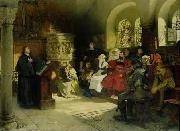 |
Hugo Vogel
|
|
painted Martin Luther preaching at the Wartburg in 1882
|
|
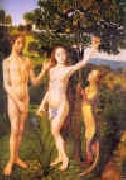 |
Hugo van der Goes
|
|
1440-1482
Flemish
Hugo van der Goes Galleries
Hugo became a member of the painters' guild of Ghent as a master in 1467. In 1468 he was involved in the decoration of the town of Bruges in celebration of the marriage between Charles the Bold and Margaret of York and he provided heraldic decorations for Charles's joyeuse entr??e to Ghent in 1469 and again in 1472. He was elected dean of the Ghent guild in 1473 or 1474.
In 1475, or some years later, Hugo entered Rooklooster, a monastery near Brussels belonging to the Windesheim Congregation, and professed there as a frater conversus. He continued to paint, and remained at Rooklooster until his death in 1482 or 1483. In 1480 he was called to the town of Leuven to evaluate the Justice Scenes left unfinished by the painter Dieric Bouts on his death in 1475. Shortly after this, Hugo, returning with other members of his monastery from a trip to Cologne, fell into a state of suicidal gloom, declaring himself to be damned. After returning to Rooklooster, Hugo recovered from his illness, and died there. His time at Rooklooster is recorded in the chronicle of his fellow monk, Gaspar Ofhuys. A report by a German physician, Hieronymus M??nzer, from 1495, according to which a painter from Ghent was driven to melancholy by the attempt to equal the Ghent Altarpiece, may refer to Hugo.
His most famous surviving work is the Portinari Triptych (Uffizi, Florence), an altarpiece commissioned for the church of San Egidio in the hospital of Santa Maria Nuova in Florence by Tommaso Portinari, the manager of the Bruges branch of the Medici Bank. The triptych arrived in Florence in 1483, apparently some years after its completion by van der Goes. The largest Netherlandish work that could be seen in Florence, it was greatly praised. Giorgio Vasari in his Vite of 1550 referred to it as by "Ugo d'Anversa" ("Hugo of Antwerp"). This the sole documentation for its authorship by Hugo; other works are attributed to him based on stylistic comparison with the altarpiece.
Hugo appears to have left a large number of drawings, and either from these or the paintings themselves followers made large numbers of copies of compositions that have not survived from his own hand. A drawing of Jacob and Rachel preserved at Christ Church, Oxford is thought to be a rare surviving autograph drawing.
|
|
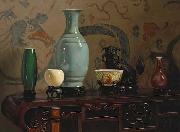 |
Hubert Vos
|
|
(1855-1935) was a Dutch painter who was born in Maastricht on February 15, 1855. He studied at the Academie Royale des Beaux-Arts in Brussels and with Fernand Cormon (1845-1924) in Paris. He exhibited widely in Paris, Amsterdam, Brussels, Dresden and Munich. From 1885 to 1892, he worked in England, where he exhibited at the Royal Academy between 1888 and 1891. He was a member of the Royal Society of British Artists.
In 1898, he visited Hawaii, where he painted the local people. In that same year, Vos traveled to Korea, where he completed at least three paintings in duplicate. In each case, he left one copy in Korea and kept one copy. The paintings are a life-sized portrait of Emperor Gojong, a portrait of Min Sang-ho (1870-1933) and a landscape of Seoul. The copies left in Korea hung in the Deoksugung Palace until all except the landscape of Seoul, were destroyed by fire in 1904. In 1905, on his second and last trip around the world.
|
|
 |
Horace Vernet
|
|
French Academic Painter, 1789-1863, Painter, son of Carle Vernet. He was born in his father's lodgings at the Palais du Louvre, where his grandfather Joseph Vernet also lived; his maternal grandfather was Jean-Michel Moreau. To these antecedents and influences are ascribed the supreme ease of his public career, his almost incredible facility and his fecundity. His early training in his father's studio was supplemented by formal academic training with Franeois-Andre Vincent until 1810, when he competed unsuccessfully for the Prix de Rome. He first exhibited at the Salon in 1812. In 1814 Vernet received the Legion d'honneur for the part he played in the defence of Paris, which he commemorated in the Clichy Gate: The Defence of Paris, 30 March 1814
|
|
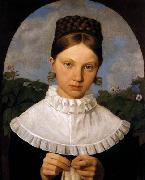 |
HESS, Heinrich Maria von
|
|
German painter b. 1798, Dsseldorf, d. 1863, Mnchen,German painter. After training (1813-17) under Peter von Langer (1756-1824) at the Akademie der bildenden Kenste in Munich, he painted religious subjects under the influence of Peter Cornelius. In 1821 he joined the Lukasbreder, and the circle around Crown Prince Ludwig I of Bavaria, in Rome. Apollo among the Muses (1824; Munich, Neue Pin.), painted for Maximilian I, shows Hess to be among the most gifted of the German artists working in Rome. The influence of Raphael, glowing but carefully harmonized colours, gliding figures and drapery animate this early masterpiece. Among other important works from this time are exquisitely detailed and colouristically sophisticated, intimate character portraits with early Renaissance settings, such as that of Marchesa Marianna Florenzi (1824; Munich, Neue Pin.), as well as fresh and lively Naturalist landscapes from the environs of Rome, for example Campagna Landscape near Ponte Nomentano (1821-6; Hamburg, Ksthalle).
|
|
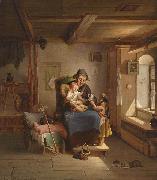 |
Hermann Volz
|
|
painted Das kleine Katzchen, signiert und datiert H. Volz Munchen in 1858
|
|
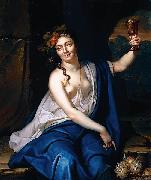 |
Herman van der Mijn
|
|
(1684, Amsterdam - 1741, London), was an 18th century painter from the Northern Netherlands.
According to Houbraken he introduced Jan van Nickelen to Jan Frans van Douven.
According to the RKD he learned to paint flowers from Ernst Stuven, and became a master of the Antwerp Guild of St. Luke in 1712, and the following year court painter to Johann Wilhelm, Elector Palatine. He took the family of Jan van Nickelen in tow to Dusseldorp, where they painted at court, and Van der Mijn taught Van Nickelen's daughter Jacoba Maria van Nickelen to paint flowers. She met the painters Rachel Ruysch and Willem Troost (whom Jacoba married) there. Van der Mijn returned to the Netherlands in 1717, but left on a trip via Brussels and Paris to London, where he stayed until 1737, when he took a trip to Leeuwarden
|
|
|
|
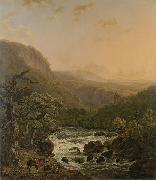 |
Henri van Assche
|
|
born at Brussels in 1774, showed from his earliest years a predilection for painting, and received from his father, who was a distinguished amateur artist, the first principles of design and perspective. He was afterwards placed with Deroy of Brussels, from whom he received further instructions in painting. Journeys in Switzerland and Italy contributed to develop his talent as a landscape painter. His great partiality for representing waterfalls, mountain streams, and mills gained for him the name of 'The Painter of Waterfalls.' Several pictures by him may be seen in public and private collections of Brussels, Ghent, Lille, and Haarlem, some of which are enriched with figures and animals by Ommeganck. He died at Brussels in 1841.
|
|
|
|
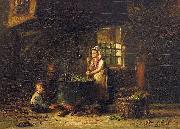 |
Hendrik Valkenburg
|
|
painted An old kitchen with a mother and two children at the cauldron in 1872
|
|
|
|
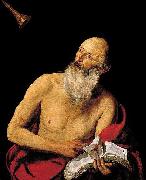 |
Hendrick van Somer
|
|
Hendrick van Someren, or Somer (1615, Amsterdam - 1685, Amsterdam), was a Dutch Golden Age painter.
According to Houbraken he was the son of the "van Zomeren" who took in the young Adriaen Brouwer after he fled Frans Hals' workshop to try his luck in Amsterdam. Houbraken claimed Henrik van Someren was a good painter of historical allegories, landscapes, and flower still lifes.
According to the RKD no works survive in the styles Houbraken mentioned, only "hermits" in the style of Ribera. He was the son of the painter Barend van Someren and the grandson of Aert Mijtens. He was the pupil of Jusepe de Ribera and at least one of his works had a forged signature of Ribera.He is possibly the same painter sometimes referred to as Enrico Fiammingo.
|
|
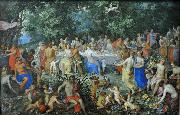 |
Hendrick van Balen the Elder
|
|
painted The Wedding of Thetis and Perseus with Apollo and the Concert of the Muses, or The Feast of the Gods in ca. 1618
|
|
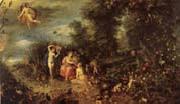 |
Hendrick van balen
|
|
Dutch Baroque Era Painter, ca.1575-1632
was a Flemish painter, who was born and died in Antwerp. Van Balen studied art while traveling in Italy. He was the teacher of Anthony Van Dyck and Frans Snyders and was also a contemporary of many of the other famous Flemish artists
|
|
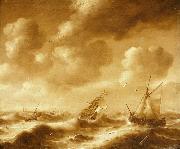 |
Hendrick van Anthonissen
|
|
(29 May 1605, Amsterdam - 12 November 1656, Amsterdam) was a Dutch marine painter.
Van Anthonissen was the son of Aert Anthonisz (a.k.a. Aart van Antum) and painted in the style of his brother-in-law and teacher Jan Porcellis and of Jan van Goyen. He is the author of sea paintings in the Hermitage, St. Petersburg and the Prague Gallery, which through their signatures have been ascribed to a mythical Hendrik van Antem. In the 1630's he lived in The Hague, Leiden, and Leiderdorp, but from 1642 he was back in Amsterdam. He is known for beach scenes and seascapes in the manner of Jan Porcellis, sometimes in grisaille. He was the father of the marine painter Arnoldus van Anthonissen.
|
|
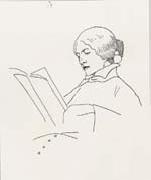 |
Heinrich Vogeler
|
|
1872-1942,German painter, printmaker and architect. He studied from 1890 to 1893 in D?sseldorf. In 1895 he bought the Barkenhoff in Worpswede, near Bremen. Soon afterwards, with colleagues from the WORPSWEDE COLONY, including Fritz Mackensen, Fritz Overbeck (1869-1909), Hans am Ende (1864-1918) and Otto Modersohn (1865-1943), he exhibited successfully at the Glaspalast in Munich. He provided illustrations for the periodical Die Insel, and undertook the interior decoration of the G?ldenkammer in Bremen. In 1906 he visited Ceylon (now Sri Lanka) for convalescence and in 1909 he went to England to study the principles of the garden city movement. He served in the German army in World War I, his writing of a pacifist letter to the Emperor in January 1918 prompting an official inquiry into his state of mental health. In 1919 he founded the Arbeitsgemeinschaft Barkenhoff in Worpswede, in an unsuccessful attempt to create an Arbeitsschule and a utopian community.
|
|
|
|
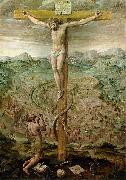 |
Hans Vredeman de Vries
|
|
(1527 - c. 1607) was a Dutch Renaissance architect, painter, and engineer. Vredeman de Vries is known for his publication in 1583 on garden design and his books with many examples on ornaments (1565) and perspective (1604).
Born in Leeuwarden and raised in Friesland, in 1546 Vredeman de Vries went to Amsterdam and Kampen. In 1549 he moved to Mechelen where the Superior Court was seating. Sebastian, his brother, was the organist in the local church. Vredeman de Vries designed ornaments for merry parades of Charles V and Philip II. Studying Vitruvius and Sebastiano Serlio, (translated by his teacher Pieter Coecke van Aelst), he became an internationally known specialist in perspective. He continued his career in Antwerp, where he was appointed city architect and fortification engineer. After 1585 he fled the city because of the Spanish occupation by Alessandro Farnese. Then the Protestants had to leave the city within two years. Vredeman de Vries moved to Frankfurt and worked in Wolfenbettel, designing a fortification and a new lay-out of the city for Julius, Duke of Brunswick-Leneburg. After his death the project was cancelled and Hans worked in Hamburg, Danzig (1592), Prague (1596) and Amsterdam (1600). On his trips Vredeman was accompanied by his son Paul and Hendrick Aerts.
Vredeman de Vries tried to get an appointment at the University of Leiden in 1604. It is not known when and where Hans Vredeman de Vries died, however, it is recorded that his son Paul was living in Hamburg when he inherited.
|
|
|
|
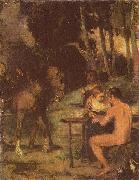 |
Hans von Marees
|
|
(24 December 1837 - 5 June 1887) was a German painter. He mainly painted country scenes in a realistic style.
Von Marees was born in Elberfeld, Germany. At age 16, he was sent to the Berlin Academy. In 1857, he moved to Munich.
In 1869, he visited France, the Netherlands and Spain. He served in the Franco-Prussian War (1870-71) and then lived in Berlin and Dresden for a while. In 1873, he decorated the library walls of the newly built Naples Zoological Institute in Italy. The next year, he moved to Florence.
He died in Rome at the age of 49 and is buried in the Protestant Cemetery there.
|
|
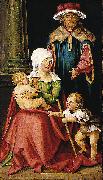 |
Hans von Kulmbach
|
|
(real name Hans Suess or Hans Seß) was born around 1480 in Kulmbach, Franconia and died previous to Dec. 3, 1522 in Nuremberg. Hans von Kulmbach was the artist who created the Krakew St. John's Altar.
Kulmbach probably arrived in Nuremberg around 1505. He received instruction by Jacopo de' Barbari, who for a time worked in Nuremberg. Von Kulmbach then apprenticed with Albrecht Derer and after Derer retired from painting altarpieces in 1510 Kulmbach took over most of his commissions. Kulmbach had his own workshop in Nuremberg and at times worked in Krakew. He also created artworks for emperor Maximilian I and for Margrave Casimir Hohenzollern von Brandenburg-Kulmbach. His best works were stained-glass windows in churches, such as the Maximilian stained-glass, Margrave stained-glass at St. Sebald in Nuremberg, the Welser stained-glass at the Frauenkirche and the Nikolaus altar at Lorenzkirche. In 1511 he finished the St. Mary's altar at Skałka in Krakew. The Catherine and St. John's altar also in Krakew, are among his best works.
|
|
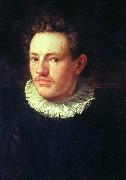 |
Hans von Aachen
|
|
was a German mannerist painter.
His name is derived from the birth place of his father, Aachen in Germany. Other variations of the name include Johann von - and - von Achen and various concisions like Janachen, Fanachen, Abak, Jean Dac, Aquano, van Aken etc.
Hans von Aachen began painting in Germany as a pupil of the Flemish master E. Jerrigh. He then moved to Italy in 1574 to study further. He toured Rome and Florence, but eventually settled in Venice. He initially became a pupil of Kaspar Rems, but soon decided to develop his own mannerist technique, by studying Tintoretto and Michelangelo's followers. However, during all of his life he was influenced by the style of Bartholomeus Spranger and Hendrick Goltzius who dominated the art scene in Germany at the time.
He returned to Germany in 1588 where he became well known as a painter of portraits for noble houses. He painted several works for Duke William V of Bavaria. He married Regina, the daughter of the composer Orlando di Lasso in Munich. In Munich he came into contact with the Imperial Court in Prague. In 1592 he was appointed official painter of Rudolph II, Holy Roman Emperor. However, Von Aachen only moved to Prague in 1601, where he stayed painting commissions from Emperor Rudolph II, and later from Matthias I.
Amongst van Aachens pupils were Peter Isaak and Joseph Heinz. His works have been copied by Wolfgang Kilian, Dominicus Custos and Jan Sadeler.
|
|
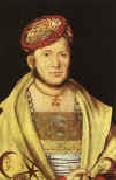 |
Hans Suss von Kulmbach
|
|
1476-1522
German
Hans Suss von Kulmbach Gallery
German painter and graphic artist. His real name was Hans S??ss. In general his work reveals the influence of D??rer, but he had little of the master's power. Von Kulmbach worked chiefly in Nuremberg, although he probably spent several years in Cracow as court painter. His masterpiece is the Tucher altarpiece for the Church of St. Sebald in Nuremberg. He also executed portraits and designs for painted glass.
|
|
|
|
|
|
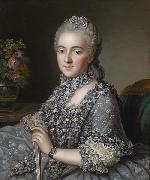 |
Guillaume Voiriot
|
|
Guillaume Voiriot (Paris, 1713 - Paris, 30 November 1799) was a French portrait painter. In the years of 1746-1749 Voiriot went, at its own expense, to Italy. After his return he became a member of the painters and sculptors guild at Academie de Saint-Luc. In the years 1759 to 1771 he regularly exhibited portraits of his contemporaries in the Paris Salon. He portrayed family members, scientists, writers, actors and musicians.
|
|
|
|
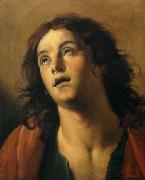 |
Giuseppe Vermiglio
|
|
Giuseppe Vermiglio (c.1585 - c.1635) was a Caravaggist painter from Northern Italy, active also in Rome.
Our knowledge of Vermiglioes life is sketchy. It is probable that he was born in Alessandria. He spent the first two decades of the seventeenth century in Rome where, while training and working as an artist, he adopted a bohemian lifestyle with a tendency to become involved in painterly brawling: in 1604 he supported his master Adriano di Monteleonees account of a dispute with two unknown artists which had led to Monteleone being wounded by his own wife; the following year Vermiglio was arrested and imprisoned after being discovered at the Monte di Brianza hostellry bearing an unlicensed sword; and in 1611 proceedings were brought against him for physically attacking the painter Silvio Oliviero. In 1618, still in Rome, he is recorded as a picture dealer.
Around 1620 he returned to northern Italy where he pursued his career as a painter in Piedmont (Novara and Alessandria) and in Lombardy (notably in Mantua and Milan).
His art was profoundly influenced by Caravaggio. Other painters to whom his work is thought, on the basis of stylistic references, to be indebted include the Bolognese Annibale Carracci and Guido Reni; it has been suggested that Vermiglio worked or studied in Bologna at some point. Luigi Lanzi acclaimed the painting of Daniel among the lions, in the library of the Passione in Milan, as his masterwork.
Judgments of quality of his work have ranged from Alfred Moires inconsequential craftsmane to Lanzies the best painter in oils of which the ancient state of Piedmont could boast, and one of the best Italian artists of his times.
|
|
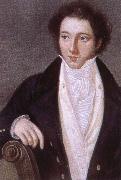 |
giuseppe verdi
|
|
Period: Romantic (1820-1869)
Country: Italy
Born: October 09, 1813 in Le Roncole, Italy
Died: January 27, 1901 in Milan, Italy
Genres: Chamber Music, Choral Music, Miscellaneous Music, Opera, Vocal Music
|
|
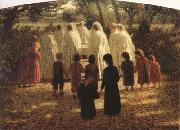 |
Giuseppe Pellizza da Volpedo
|
|
Italian, 1868-1907
was an Italian painter. He was born and died in Volpedo, in the Piedmont region of northern Italy. Pellizza, considered a neo-impressionist artist, was a divisionist painter - using small dots of paints according to specific color theory. His most famous work is Il Quarto Stato ("The Fourth estate"). This rich, expressive work has become a well-known symbol for progressive and socialist causes in Italy, and through out Europe.
|
|
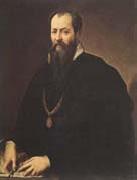 |
Giorgio Vasari
|
|
1511-74
Italian painter, architect, and writer. Though he was a prolific painter in the Mannerist style, he is more highly regarded as an architect (he designed the Uffizi Palace, now the Uffizi Gallery), but even his architecture is overshadowed by his writings. His Lives of the Most Eminent Architects, Painters, and Sculptors (1550) offers biographies of early to late Renaissance artists. His style is eminently readable and his material is well researched, though when facts were scarce he did not hesitate to fill in the gaps. In his view, Giotto had revived the art of true representation after its decline in the early Middle Ages, and succeeding artists had brought that art progressively closer to the perfection achieved by Michelangelo.
|
|
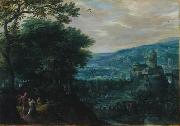 |
Gillis van Coninxloo
|
|
(1544 ?C 1607) was a Dutch painter of forest landscapes, the most famous member of a large family of artists. He travelled through France, and lived in Germany for several years to avoid religious persecution.
He was born at Antwerp and studied under Pieter Coecke van Aelst, Lenaert Kroes and Gillis Mostaert. He practiced his art in France, but in 1587, on account of religious persecution, emigrated to Frankenthal and passed his later life in Amsterdam, where he died in 1607.
Coninxloo ranks as one of the most important Dutch landscape painters of the transition from the sixteenth to the seventeenth century. He exercised a strong influence on Jan Brueghel the Elder, Schoubroeck, Savery, and other Flemish and Dutch landscape painters of the transition period. Coninxloo is considered the founder of a new approach to the painting of forests; while earlier forest landscapes had used woods as backdrops for human activity, van Coninxloo made them a subject, submerging tiny human figures in elaborate compositions of trees in hugely exaggerated scale.
During his stay at Frankenthal from 1588 to 1595, he influenced several better known Dutch landscape-painters collectively referred to as the Frankenthal School. Karel van Mander wrote about him and his father Jan den Hollander in his Schilder-boeck. He wrote that his teacher Pieter Coeke van Aelst was his cousin, and that his landscapes were among the best of all Dutch landscape artists.
|
|
|
|
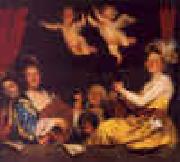 |
Gerrit van Honthorst
|
|
1590-1656
Dutch
Gerrit Van Honthorst Galleries
Gerard van Honthorst (November 4, 1592 - April 27, 1656), also known as Gerrit van Honthorst and Gherardo della Notte, was a Dutch painter of Utrecht. He was brought up at the school of Abraham Bloemaert, who exchanged the style of the Franckens for that of the pseudo-Italians at the beginning of the 16th century.
Margareta Maria de Roodere and Her Parents by Gerrit van Honthorst (1652) Oil on canvas, 140 x 170 cm. Centraal Museum, UtrechtInfected thus early with a mania which came to be very general in the Netherlands, Honthorst went to Italy in 1616, where he copied the naturalism and eccentricities of Michelangelo da Caravaggio. Home again about 1620, after acquiring a considerable practice in Rome, he set up a school at Utrecht which flourished exceedingly. Together with his colleague Hendrick ter Brugghen, he represented the so-called Dutch Caravaggisti. In 1623 he was president of his gild at Utrecht, where he had married his cousin. He soon became so fashionable that Sir Dudley Carleton, then English envoy at The Hague, recommended his works to the earl of Arundel and Lord Dorchester. In 1626 he received a visit from Rubens, whom he painted as the honest man sought for and found by Diogenes.
The queen of Bohemia, sister of Charles I of England and electress palatine, being in exile in the Netherlands, gave Honthorst her countenance and asked him to teach her children drawing; and Honthorst, thus approved and courted, became known to her brother Charles I, who invited him to England in 1628. There he painted several portraits, and a vast allegory, now at Hampton Court, of Charles and his queen as Diana and Apollo in the clouds receiving the duke of Buckingham as Mercury and guardian of the king of Bohemia's children. Charles I, whose taste was flattered alike by the energy of Rubens and the elegance of Van Dyck, was thus first captivated by the fanciful mediocrity of Honthorst, who though a poor executant had luckily for himself caught, as Lord Arundel said, much of the manner of Caravaggio's colouring, then so much esteemed at Rome.
|
|
|
|
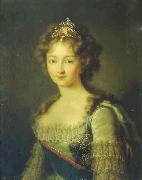 |
Gerhard von Kugelgen
|
|
Franz Gerhard von Kegelgen (February 26, 1772 - March 27, 1820) was a German painter, noted for his portraits and history paintings. He was a professor at the Academy of Arts in Dresden and a member of both the Prussian and Russian Academies of Arts. His twin brother, Karl von Kegelgen, was also a painter of note.
Gerhard von Kegelgen was born at Bacharach am Rhein. After leaving school in 1789, he studied painting in Koblenz. Beginning in 1791, he worked in Bonn, where he painted portraits of Elector Archduke Maximilian Franz of Austria, minister Ferdinand August von Spiegel zum Desenberg, and the Earl of Waldstein. Afterwards, Gerhard von Kegelgen and his brother undertook an educational journey to Rome, Munich and Riga, which was financed by Maximilian Franz of Habsburg.
In 1800, Kegelgen married Helene Marie Zoege von Manteuffel. They had three children together. His first son, Wilhelm was born in Saint Petersburg in 1802, and also grew up to become a painter. The other children were Gerhard (born 1806), and Adelheid (born 1808).
|
|
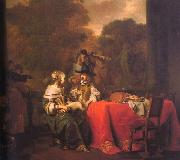 |
Gerbrand van den Eeckhout
|
|
1621-1674
Dutch
Gerbrand van den Eeckhout Location
Dutch painter, draughtsman and etcher. He was the son of the goldsmith Jan Pietersz. van den Eeckhout and a great friend as well as a pupil of Rembrandt, according to Houbraken, who commented that van den Eeckhout painted in the style of his master throughout his career. This is certainly true of van den Eeckhout (biblical) history paintings, but less so of either his portraits, which gradually displayed more Flemish elegance, or his genre pieces (from 1650), in which he followed various trends; he adapted his style to suit his subject with sensitive versatility. He was also a gifted colourist and an artist of great imagination, superior in both these respects to such better-known Rembrandt pupils as Ferdinand Bol and Nicolaes Maes. Moreover, he was extremely productive, and there is at least one dated painting for virtually every year between 1641 and 1674. In addition, he created a large body of drawings comprising histories, figures, landscapes and genre scenes executed in various media, including watercolour. He also made several etchings, mostly studies of heads, such as the Self-portrait (1646; B. 66). He died a bachelor, aged 53.
|
|
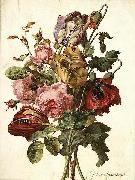 |
Gerard van Spaendonck
|
|
(22 March 1746 - 11 May 1822) was a Dutch painter.
Gerard was born in Tilburg, an older brother of Cornelis van Spaendonck (1756-1840), who was also a renowned artist. In the 1760s he studied with decorative painter Willem Jacob Herreyns (also known as Guillaume-Jacques Herreyns) (1743-1827) in Antwerp. In 1769 he moved to Paris, and in 1774 was appointed miniature painter in the court of Louis XVI. In 1780 he succeeded Madeleine Françoise Basseporte (1701-1780) as professor of floral painting at the Jardin des Plantes, and shortly afterwards was elected a member of the Academie des beaux-arts.
Gerard van Spaendonck painted with both oil and watercolors. He contributed over fifty works to the Velins du Roi, which was a famous collection of botanical watercolors possessed by French royalty. From 1799 to 1801 he published twenty-four plates of his Fleurs Dessinees d'apres Nature (Flowers Drawn from Life), which were high-quality engravings for students of floral painting. Today, Fleurs Dessinees d'apres Nature is a highly treasured book on floral art.
In 1788 Spaendonck was appointed adviser to the Academie, and in 1795 he became a founding member of the Institut de France. In 1804 he received the Legion d'honneur and soon afterwards was ennobled by Napoleon Bonaparte. He died in Paris.
|
|
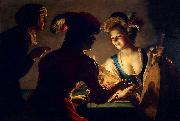 |
Gerard van Honthorst
|
|
(November 4, 1592 - April 27, 1656), also known as Gerrit van Honthorst and Gherardo della Notte, was a Dutch painter of Utrecht. He was brought up at the school of Abraham Bloemaert, who exchanged the style of the Franckens for that of the pseudo-Italians at the beginning of the 16th century.
Margareta Maria de Roodere and Her Parents by Gerrit van Honthorst (1652) Oil on canvas, 140 x 170 cm. Centraal Museum, UtrechtInfected thus early with a mania which came to be very general in the Netherlands, Honthorst went to Italy in 1616, where he copied the naturalism and eccentricities of Michelangelo da Caravaggio. Home again about 1620, after acquiring a considerable practice in Rome, he set up a school at Utrecht which flourished exceedingly. Together with his colleague Hendrick ter Brugghen, he represented the so-called Dutch Caravaggisti. In 1623 he was president of his gild at Utrecht, where he had married his cousin. He soon became so fashionable that Sir Dudley Carleton, then English envoy at The Hague, recommended his works to the earl of Arundel and Lord Dorchester. In 1626 he received a visit from Rubens, whom he painted as the honest man sought for and found by Diogenes.
|
|
|
|
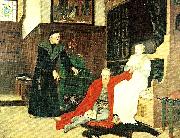 |
georg von rosen
|
|
Johan Georg Otto von Rosen, född 13 februari 1843 i Paris, död 1923 i Stockholm, var en svensk konstnär och greve av ätten von Rosen. Han målade i den akademiska stilen, till stor del historiemåleri och porträtt. Han var professor vid Konstakademien 1880-1908 och dess direktör 1881-1887 samt 1893-1899. Som konstakademiens direktör kom han i stark konflikt med den nya generation av konstnärer som krävde reformer av akademiens utbildning och utställningsverksamhet, de så kallade opponenterna.
Georg von Rosen föddes i Paris 1843 som son till generalkonsuln greve Adolf Eugene von Rosen (kallad "de svenska järnvägarnas fader") och hans hustru Euphrosyne Rizo-Rangabe. Hans första levnadsår förflöt i Paris, varifrån familjen flydde till Sverige under februarirevolutionen 1848. Han studerade 1855-1861 vid Konstakademien i Stockholm. 1862 besökte Rosen världsutställningen i London där han lärde känna belgaren Henri Leys' arbeten, målningar med scener från medeltiden och renässansen målade i ålderdomlig stil. Dessa verk gjorde ett stort intryck på von Rosen. Han skrev själv
Stående hvarje dag i flere timmar, försjunken i åskådandet af dessa om en snart sagdt öfvermänsklig intuition vittnande bilder, som likväl flertalet i den stora hopen med likgiltighet skred förbi, drömde jag mig tillbaka in i en hänsvunnen tid och för mina yttre ögon försvann hela den öfriga utställningen, den omgifvande mängden, ja hela den existerande verlden! Då jag lemnade London, var jag på 14 dagar vorden 300 år äldre.
Rosen uppsökte följande året mästaren i Antwerpen och tillbringade en tid i hans umgänge och i hans atelje. Återkommen till Sverige, inspirerad av mötet, målade han Sten Sture d.ä. intåg i Stockholm. Den medeltida stadsmiljön med det noggranna återgivandet av stenläggningen och den närmast osannolika rikedomen på byggnadsdetaljer känns igen från Leys målningar. von Rosen belönades med kunglig medalj för målningen, och blev hyllad och uppskattad av Oscar II på grund av bildspråket, som i hög grad uttryckte den oscarianska epokens ideal. Samma år begav han sig ut på resa och besökte Egypten, Palestina, Syrien, Osmanska riket, Grekland och Ungern där han studerade måleri. 1866 vistades han ett år i Rom och vistades sedan åter hos Leys fram till dennes död 1869. Därefter studerade han i Menchen under Karl Piloty och reste sedan vidare till Italien innan han återkom till Sverige 1871. Efter hemkomsten målade han Erik XIV och Karin Månsdotter.
1872 blev han ledamot av Konstakademien, 1874 blev han vice professor, 1879 kammarherre och 1880 professor i figurteckning och målning. 1881-1887 samt 1893-1899 var han direktör för Akademins läroverk. 1892-1900 var han även ordförande i Nordiska samfundet till bekämpande av det vetenskapliga djurplågeriet, numera Djurens Rätt.
Han avled 1923 och förblev ogift under hela sitt liv.
|
|
|
|
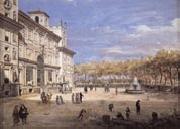 |
Gaspar Van Wittel
|
|
Dutch Baroque Era Painter, ca.1653-1736
was a Dutch landscape painter. Van Wittel learned painting in his hometown of Amersfoort. His first extant works were made in Hoorn in 1672, but he relocated to Rome with his family ca. 1675 and made his career there. In Amersfoort, he likely was exposed to Dutch landscape artists such as Jan van der Heyden and Gerrit Berckheyde. He married in Rome in 1697, and stayed most of his life in that city, though, between 1694 and 1710, he toured Italy and painted in places like Florence, Bologna, Ferrara, Venice, Milan, Piacenza and Naples. He is one of the principal painters of topographical views known as vedute. His son Luigi would become a famous architect and also carries the italianized family name of Vanvitelli. In Luigi's biography is written that his father was born in July 1656,
|
|
|
|
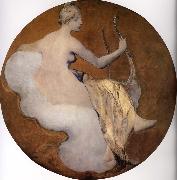 |
Galland Pierre Victor
|
|
Geneve 1822-Paris 1892
He studied metalwork with his father Jacques Galland, an accomplished goldsmith, until age 16. He then entered the studio of Henri Labrouste to study architecture. After two years of training, Labrouste encouraged him to pursue his interest in decorative painting under the direction of Michel-Martin Drolling. In 1843 the decorative painter Pierre-Luc-Charles Ciceri (1782-1868) hired Galland to assist with the painting of figures, flowers, garlands and fruit. He worked again with Labrouste, in 1848, on the decoration of the national festival, the F?te de la Concorde.
|
|
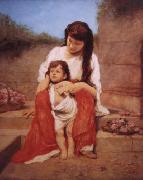 |
Gabriel von Max
|
|
(August 23, 1840 - November 24, 1915) was a Prague-born Austrian painter.
He was born Gabriel Cornelius Max, the son of Czech sculptor Joseph Max and Anna Schumann. He studied between 1855 and 1858 at the Prague Academy of Arts with Eduard von Engerth. His studies included parapsychology (somnambulism, hypnotism, spiritism), Darwinism, Asiatic philosophy, the ideas of Schopenhauer, and various mystical traditions. The spiritual-mystical movement was emphasized by the writings of Carl du Prel, and the Munich painter Albert Keller was also an influence.
His first large canvas was painted in 1858 while he was a student at the Prague Academy. He continued his studies at the Viennese Academy of Art with Karl von Blaas, Karl Mayer, Christian Ruben and Carl Wurzinger. From 1863 to 1867 he studied at the Munich Academy with Karl Theodor von Piloty, and also Hans Makart and Franz Defregger. His first critical success was in 1867 with the painting "Martyr at the Cross": that painting transformed the "Ungl?-ksmalerei" (dark palette) of Piloty into a religious-mystical symbolism using a psychological rendering of its subject.
He continued to use the dark palette of the Piloty school well into the 1870s, later moving toward a more muted palette, using fewer,clearer colors. From 1869, Gabriel von Max had his studio in Munich; in the summer, he was in the Ammerland at Starnberger Lake. From 1879-1883, Gabriel Max was a professor of Historical Painting at the Munich Academy; he also became a Fellow of The Theosophical Society. In 1900 he was ennobled and became a Ritter. He died in Munich in 1915.
His interest in anthropological studies also showed in his work. He owned a large scientific collection of prehistoric ethnological and anthropological finds: the collection now resides in the Stadtischen Reiss Museum in Mannheim. At his residence in Starnberger Lake, Gabriel Max surrounded himself with a family of monkeys, which he painted often, sometimes portraying them as human. Max, along with his colleagues, often used photographs to guide painting. The great number of monkey photographs in his archive testify to their use as direct translation into his paintings. In 1908, his painting "The Lion's Bride" became celebrated, and was depicted in motion pictures as an hommage in the Gloria Swanson film, Male and Female, (1919), directed by Cecil B. de Mille.
Gabriel von Max was a significant artist to emerge from the Piloty School, because he abandoned the themes of the Grunderzeitliche (genre and history), in order to develop an allegorical-mystical pictorial language, which became typical of Secessionist Art. Characteristic of the ethereal style of Gabriel Max is "The Last Token" (in the Metropolitan Museum), and "Light" (in the Odessa Museum of Western and Eastern Art, Ukraine).
|
|
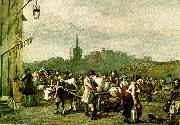 |
fritz von dardel
|
|
Fritz Ludvig von Dardel, född den 24 mars 1817 i Neuchâtel, död den 27 maj 1901 i Stockholm, var en schweiziskfödd svensk överintendent, militär, målare och tecknare.
Fritz von Dardel var son till godsägaren Georges-Alexandre von Dardel och grevinnan Hedvig Sofia Charlotta Amalia Lewenhaupt. Han var gift med friherrinnan Augusta Silfverschiöld. Släkten von Dardel kommer från Schweiz och adlades i Sverige 1810.
Von Dardel blev vid sexton års ålder konstapelkadett vid Vendes artilleriregemente, 1837 underlöjtnant vid Svea livgarde och avancerade till överstelöjtnant i armen 1862. Han blev 1850 adjutant hos kronprinsen och sedan hos Karl XV. Von Dardel var 1858-62 militärattach?? i Paris samt blev 1864 kabinettskammarherre hos Karl XV och samma år överintendent och ordföranden i Akademin för de fria konsterna, av vilken han 1861 invalts till hedersledamot. Dessutom var han ordförande i Nationalmuseums nämnd i 25 år (1867-92).
Vid flera konstutställningar i Europa (1867, 1871, 1873 och 1878) samt i Philadelphia (1876) var han juryman.
Själv hade von Dardel bedrivit studier på L??on Cogniets och E. Lamis ateljeer i Paris.
Fritz von Dardel tillhörde Karl XV:s intima krets och har gjort ett flertal dråpliga, akvarellerade teckningar av personer och händelser vid hovet eller under kungens resor, vidare folklivsbilder samt litografier. Hans dagböcker (se nedan) som utgavs postumt är skrivna på franska och översatta och redigerade av hans söner.
|
|
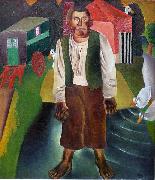 |
Frits Van den Berghe
|
|
(3 April 1883 - 22 September 1939) was a Belgian expressionist painter.
He was born at Ghent. Like his friends Constant Permeke and Gustave De Smet, he first adopted the late-impressionist style of Emile Claus, but converted to expressionism during World War I.
|
|
|
|
|
|
|
|
|
| Wholesale China Oil Painting Wholesale Oil Painting China Xiamen Portrait Reproduction on canvas Chinese Oil Painting Wholesale USA Oil Painting |
|
|
|
|
|